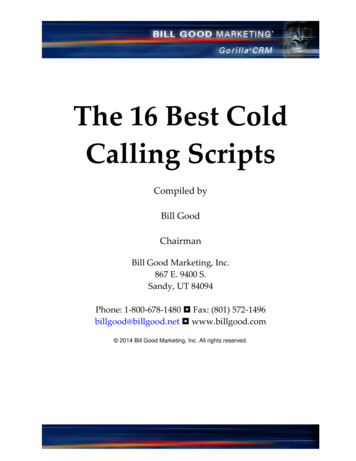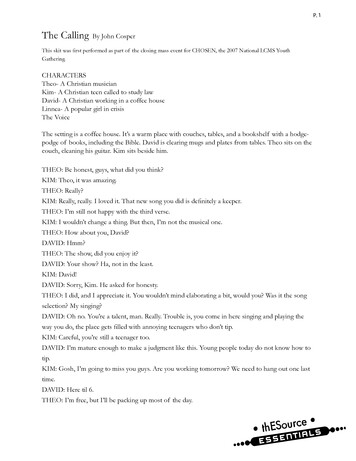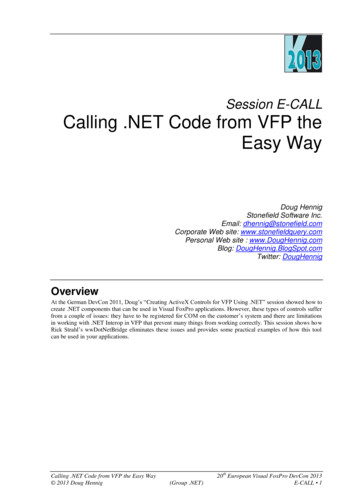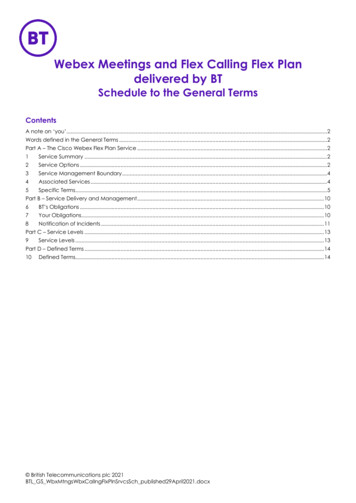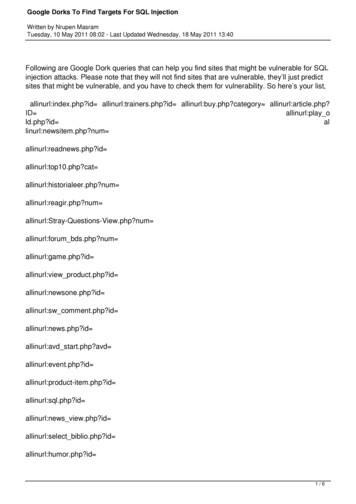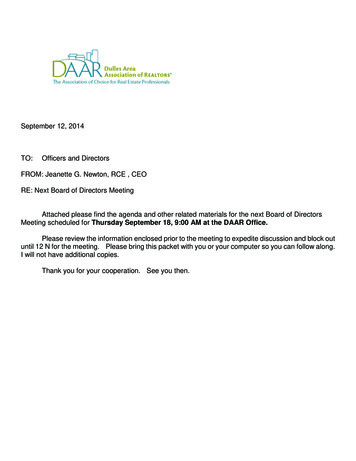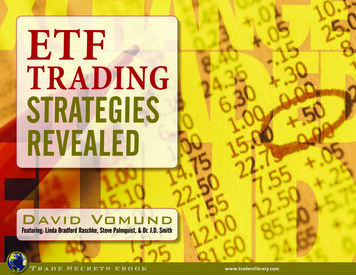
Transcription
PRICEHEADLEYPrice Headley could be your personal trading coach!Would you like to regularly talk with Price about the markets, stocks,options, superior indicators and most profitable methods?Would you like to really learn the most proven approaches tomaximize profits in bull, bear and flat markets?Would you like to take great strides toward your fullest potentialfrom the comfort of your own home or office?Some of the features of this year-long coaching program are.52 1-hour LIVE Coaching SessionsPrivate Access to a Coaching Discussion BoardSix LIVE Trading SessionsPrice Headley’s bestseller, Big Trends in TradingEleven LIVE Q&A SessionsThe Exclusive Coaching Student Handbook!SUBOPassNto One BigTrends Live Seminar,Subscription to BigTrends Exclusive Charts,16 all-new Coaching-Exclusive DVDsAND Subscription to the BigTrends NetLetterFind out more by calling1-800-244-8736 today!
Choose any of these best-sellinginvestment guides for only 4.99!Just click here or go to www.traderslibrary.com/ebookdeal
ETF TRADING STRATEGIES REVEALEDDTI offers education, training and software for individuals who are interested in learning to managetheir own portfolio. With over 50 years combined experience in the stock market, DTI Instructors teachthe novice trader the foundation of the futures market while also offering the more advanced traderstrategies for trading in the 24-hour global market.EDUCATIONOffering world-class training fortraders and investors. Coursesare available online or onsite atDTI Headquarters.THE STOCKYARD REPORTDTI’s StockYard Report gives you the necessary tools to make money in ANYmarket. No matter if the market is up, down, or completely flat, the StockYard willgive you a strategy for trading in the equities market!Your FREE TRIAL Includes:SOFTWAREWeekly Email with Hot Stock PicksSoftware that provides a realworld, real-time heads up look atthe global markets. Helping todetermine crystal clear entry, exitand target prices for stock,futures and options.Entry, Exit & Stop Parameters for Equity TradesMarket Insight from 25 Year Veteran TraderBonus: SPECIAL MONTHLY REPORT on Portfolio ManagementSUPPORTStay in touch through DTI’s dailyemails, chat room and monthlynewsletters.Well-trainedDTITraders provide a lifetime of supportvia e-mail, phone, and one-on-onementoring on an on-going basis.FREE2-Week Trial ofStockYard"I bought 100 shares of SPWR at 58.15 andsold half at 63.53 and half at 64.95 makingme over 600 in a week! Thanks StockYard!"— Mike S. Andover, MA877-369-5818WWW.DTITRADER.COM800-745-7444Past Performance is Not Indicative of Future Results.table of contentswww.traderslibrary.comprevious pagenext pageCLICK HERE to purchase the print version of this book.
TABLE OF CONTENTSPublished by the Marketplace Books 2007All rights reserved.Reproduction or translation of any part ofthis work beyond that permitted by section 107 or 108of the 1976 United States Copyright Act without thepermission of the copyright owner is unlawful. Requestsfor permission or further information should be addressedto the Permissions Department at Marketplace Books,9002 Red Branch Road, Columbia, MD 21045,(410) 964-0026, fax (410) 964-0027.ISBN 13: 978-1-59280-270-8ISBN 10: 1-59280-270-2The publisher is pleased to present this book in digitalformat—a more sustainable and interactive alternativeto traditional print publishing. The electronic mediumsignificantly reduces carbon emissions and ensures thatmore trees can remain standing—especially if you canrefrain from printing your book to hard copy.page INTRODUCTION2pART I:3THE BASICS OF ETFSChapter 1: First Things to Know aboutExchange-Traded Funds3pART II:CHART ANALYSIS6Chapter 2: Valuable Advice from LindaBradford Raschke6Chapter 3: Steve Palmquist &ETF Trading Techniques11pART III:20MECHANICAL ROTATION STRATEGIESChapter 4: Market Rotation Strategy21Chapter 5: Types of Variations26Chapter 6: Sector ETF Rotation Using StyleIndex Model28CHAPTER 7: Sector ETF Rotation Research31Chapter 8: Sector ETF Trading Model32PART III CONCLUSION:Back Testing Assumptions34pART IV:35TRADING PSYCHOLOGYChapter 9: Dr. J.D. Smith Offers a PersonalTrading Process35APPENDIX I: RECOMMENDED READING37ABOUT THE AUTHOR38
ETF TRADING STRATEGIES REVEALEDIntroductionis needed to start succeeding inETF investing.This book presents a revolutionaryapproach to making money usingclassic technical analysis tradingtechniques. How can somethingbe both revolutionary and classic?We apply classic technical analysistechniques to a new and growinginvestment vehicle—the ExchangeTraded Fund.Part II details the classic technicalanalysis technique of using chartanalysis to trade ETFs. Both shortterm and longer-term methods arediscussed.Many books claim to reveal revolutionary new trading techniques.Like fad diets, these techniquesslowly fade away to be replacedwith other “new and improved”systems. The approach in this bookis different. We apply classic technical analysis techniques that haveworked in the past and because oftheir simplicity will continue towork in the future.The techniques and mechanicaltrading systems covered in thebook are easy to learn and can besuccessfully employed by mostpeople. That doesn’t mean thismaterial is bedtime reading. Usinga highlighter and a notepad wouldbe appropriate.The book is divided into four parts.Part I describes what ETFs are andhow they work. It includes all thatPart III covers simple but highlyeffective mechanical ETF rotationtechniques. These techniques areapplied to the different categoriesof ETFs (style, sector, and international) that are now available tothe individual investor.Part IV takes a brief look at trading psychology. While we offerseveral highly effective techniques,they work best when tailored toyour personal trading style andwhen you have the emotionaldiscipline to follow them. This isan important subject and is oftenignored, to the detriment of manytraders.In creating this book, our goalwas to include all the relevantmaterial necessary for trading ofETFs, while leaving out the fluff.We attempted to incorporate inthis book as much useful information as one would find in a bookten times its size. We believe ourmission is accomplished. We thinkyou’ll agree.If you had access to picks BEFOREthey made huge moves of 197%, 219% & 324% — how muchmoney could you make?Don’t miss out on HUGE gainsand WINNING picks!Sign up for Smart Trade Digest today for only 17.95and start getting the best forecasting, analysis andstock picks from the world’s top traders.Click here or go towww.SmartTradeDigest.com/bonustable of contentswww.traderslibrary.compage previous pagenext pageCLICK HERE to purchase the print version of this book.
Part ITHE BASICSOF ETFsPart I is a brief description ofExchange-Traded Funds and howthey work—all you need to knowto successfully trade them.Exchange-Traded Funds (ETFs)are the fastest growing financialproduct in the United States.While still small, many expectthey will eventually overtake mutual funds in assets. Mutual fundcompanies are aware of this andthe largest fund families—Fidelityand Vanguard—have introducedtheir own ETFs.If you desire more detailedinformation, check the web sitesthat we list near the end of thebook. For more comprehensivebooks on the subject, see AppendixI: Recommended Reading.Chapter 1First Things to Know aboutExchange-Traded FundsExchange-Traded Funds (ETFs) have exploded in popularity. Outside of Wall Street, however, fewpeople know what they are. That is changing. In time, ETFs will be as commonly known to people asmutual funds are.ETFs were introduced in the United States in 1993 with the advent of the Standard & Poor’s DepositoryReceipt, commonly known as S&P 500 Spyder (SPY). ETFs didn’t become well known, however, until the late1990s when the very popular Nasdaq 100 ETF (QQQQ) was introduced. Investors have quickly learned thatETFs provide a convenient way to gain market exposure to a domestic sector, a foreign market, or a commodity with one single transaction.As a result, ETFs have become the fastest growing financial product in the United States. By the end of 2005,the number of publicly traded ETFs was about 200 with assets of around 300 billion.ETFs are securities that combine elements of index funds, but do so with a twist. Like index funds, ETFsare pools of securities that track specific market indexes at a very low cost. Like stocks, ETFs are traded onmajor U.S. stock exchanges and can be bought and sold anytime during normal trading hours. Buy andsell orders are placed with any brokerage firm. Many of the execution tactics suitable for stocks can also beapplied to ETFs, from stop and limit orders to margin buying. They can be shorted and often have optionslisted on them.DiversificationSimilar to index mutual funds, most ETFs represent ownership in an underlying portfolio of securities thattracks a specific market index. That index may cover an entire market, or slices of the market broken downby capitalization, sector, style, country, etc. So today’s investor can buy an entire market segment, includinginternational markets, with one trade.ETFs track very closely to their underlying market index. Figure 1 shows the S&P Small-Cap 600 Value Index. Below that is the iShares S&P 600 Value ETF that tracks the above index. Notice that their price movement shows a nearly perfect correlation. That is to be expected. If they were to deviate, arbitrageurs wouldenter to profit from the discrepancy.page
Owning a basket of securities ismuch more comfortable than owning a few individual stocks. WithETFs, you don’t have to worry thatyour stock holding will gap down20% after an unexpected profitwarning is issued. Because of theirdiversification, the price movementin ETFs is more predictable than inindividual stocks.The strategies that will be outlinedin this book are tactical in natureand are intended to strengthena portfolio by diversifying it, yetchannel the diversification towardspecific, outperforming marketsectors.CostsWhen it comes to running aninvestment fund, there will alwaysbe costs. These costs can includeanalyst fees, marketing costs, andadministrative costs. Generally,index funds are cheaper to managethan actively managed funds. Sincemost ETFs are index funds, theirexpenses are generally well belowthose of actively managed mutualfunds. Even when you comparesimilar products, ETF expenses aregenerally lower. For example, thepeople who add regularly to theirinvestments. Mutual funds are alsoable to re-invest quarterly dividends, an advantage for those whobuy-and-hold.Figure 1- AIQ ChartsTaxesComparison of S&P Small-Cap 600 Value Index (upper chart) and the iSharesS&P 600 Value ETF (lower chart). Comparison shows how closely the ETF tracksthe index.Source: AIQ SystemsVanguard Index 500 has a very lowexpense ratio of 0.18% of assets,but the iShares S&P 500 ETF ischeaper still, with an expense ratioof 0.09%.The biggest cost advantage of ETFsover traditional index mutualfunds is in back-end expenses. Index mutual funds have to maintainthe individual account balancesand mail statements and must havea staff ready to open and close ac-counts. With ETFs, these expensesare eliminated, making fundscheaper to manage.To be fair, there may be overridingreasons favoring mutual funds forsome investors. For example, if youinvest small sums at regular intervals then mutual funds are moreappropriate. Because ETFs tradelike stocks, investors pay a brokerage commission each time they buyor sell, making them expensive forpage ETFs are typically more tax efficient than mutual funds. Mutualfunds sometimes have to sell holdings to meet the need of redemptions, which triggers a capital gaindistribution for all fund shareholders. Anyone who bought a mutualfund in early December and endedup paying taxes on other people’sgains knows that’s no fun!With ETFs, shares are bought andsold on the open market so if oneinvestor cashes out it doesn’t affectothers. The after-hours tradingscandal in mutual funds doesn’tapply to ETFs.LiquidityBefore assessing liquidity we needto understand what liquidity is andwhy the lack of it is a bad thing.A liquid investment is one thatcan quickly be bought and sold atits fair market value. Individualpurchases and sales of the security
should not affect its price. Liquidityis generally measured by the number of shares traded per day.Thinly traded securities are considered illiquid. As a result, theyhave high spreads (the differencebetween the bid and the ask prices),which adversely affects the execution cost. Trading illiquid investments can be expensive.Since ETFs trade like stocks, it’sreasonable to assume their liquidity should be judged in the samemanner as stocks. That’s a commonmisconception about ETFs, evenamong Wall Street professionals.Unlike stocks, the number ofshares in an ETF is not fixed. Thatis, if the demand for a given ETFoutstrips supply at any point, thena specialist may simply create newshares from a basket of the underlying securities in that fund. Sharesare created or redeemed to meetdemand. Therefore the liquidity ofan ETF is not only defined by itsvolume, but also by the liquidity ofits holdings. So you might see aninternational emerging market ETFwith a lot of volume that is actuallyless liquid than a domestic large-cap value ETF that trades withlower volume.If an ETF and a stock both have30,000 shares traded on a particular day, the ETF will typically bemore liquid. That is, your order ismuch less likely to move the price.In a few cases, block orders that Iplaced were more than half of thetotal volume for an ETF on a particular day. Expecting that it wouldtake a long time to get a fair execution, I’ve been pleasantly surprisedto get immediate execution at themarket price.ume. Unfortunately, many ETFsdon’t trade very much. Active traders should stick with the ETFs likethe S&P 500 SPDR (SPY), Nasdaq100 (QQQQ), or Russell 2000(IWM), all of which have high volume and narrow spreads.When you place an order for a lowvolume ETF, don’t use a marketorder. Instead, place a limit orderbetween the bid and the ask price.Unless it is a fast moving market,you’ll almost always get a quickexecution.For the typical investor, this shouldbe comforting. It doesn’t mean,however, that shares are createdor redeemed for your order. Thisprocess is typically done for institutional investors that trade 50,000shares or more. The party on theother side of most ETF transactionsis a market maker or another investor. For most retail orders, a marketorder is sufficient. The bid-to-askspreads in ETFs tend to be narrowand cover a large number of shares.With that said, buying or sellingETFs with high daily volume ismore attractive (in terms of spread)than trading ETFs with low volpage NEW DVDETF Trading Tactics:Using the Power of theMarket to Make MoneyDavid VomundDavid Vomund’s 90-minute presentation gives you everythingyou need to get started in trading ETFs. Vomund’s rock-solidand simple strategies for evaluating and rotating ETFs willhave you on your way to profiting in no time.go to - www.traderslibrary.com
Part IICHARTANALYSISPart II covers the important topicof chart interpretation. For help,I’ve turned to two technicians thatI very much admire. Both areprofessional traders who strivefor consistency—their goal is tomake money in all market environments. At the core of their analysisis chart pattern interpretation.“The chart tells all.”Linda Bradford Raschke activelytrades equities and futures. Sheexplains how the same analysistechniques are successfully appliedto trading ETFs. While the techniques may be the same, she explains how ETFs should be analyzedunder different time horizons.Steve Palmquist’s contribution is amarket adaptive approach. Hevaries his style of analysis basedon the market condition. Hisarticle details his approach totrading, including buy, sell, andcapitalization rules.Chapter 2Valuable Advice from Linda Bradford RaschkeLinda is president of LBRGroup, a CTA firm that manages money in both futures and equities. She isfeatured in Jack Schwager’s book, The New Market Wizards, and co-authored the best selling bookStreet Smarts—High Probability Short Term Trading Strategies.The following is an interview that I conducted with Linda focusing on methods for trading ETFs.Linda Bradford RaschkeVomund: Is it worth day-trading ETFs?Raschke: In my opinion, no. There are far better vehicles for day-trading. Either futures or higher beta stocksare better. The problem is that few ETFs have the volume and liquidity for fast and effective execution, andthe ones with sufficient volume tend to be the slower movers.ETFs are so broad and encompassing that they can be classified into two groups. A small number of ETFsare heavily traded and very liquid, such as Spyder (SPY) that tracks the S&P 500, but most aren’t liquidenough for active day-trading. Many global and sector ETFs might only trade 50,000 shares a day.The vehicle you choose to use for day-trading depends on your execution platform, your commission structure, and your objectives. I know people who successfully trade the Spyder (SPY), but most professional daytraders will choose the E-mini S&P Futures instead because of the greater leverage.The advantage of ETFs is that they cover such a broad spectrum. They allow investors to easily buy equitiesfrom many countries or individual sectors. And because an ETF contains a basket of stocks, one bad appleis usually offset by the other stock holdings. When you trade a basket of stocks, you’ll do better trading alonger time frame as opposed to a shorter time frame. Longer time frame charts show smoother price movement and less noise.Vomund: So professional day-traders typically aren’t interested in trading ETFs. How about the tradinginvestor? By that I mean someone who doesn’t follow the market throughout the day but places trades with aholding period of several days to a few weeks.page
Raschke: The more volatility andliquidity an individual market has,the shorter the time period that youcan trade and use for your analysis.With ETFs, I’d use daily and weeklycharts exclusively and turn off thereal-time charts. If you placed anorder on many of the foreign marketETFs, you might as well execute theorder on the open or the close because these ETFs don’t trade muchthroughout the day.Still, whether you use intradaycharts or weekly charts, you always go through the same processof determining if you should be abuyer or a seller, determining support and resistance, determiningthe trend, determining consolidation points, etc. The foreign ETFswere some of the best investmentvehicles last year.Vomund: What methods do youuse to time your entry points?Raschke: Because ETFs hold baskets of stocks and are more diversified than individual stocks, theyrespond very well to simple chartanalysis. I believe that there areno more powerful tools than thetechniques that have been writtenabout in classic technical analysisliterature. I trade the basic chartpatterns like the triangle. I tradebreakouts, and I trade pullbacksafter breakouts.Figure 2 - EWJ 12/30/05This is simple stuff but it is all thatis needed to be successful, and iteliminates a lot of the noise in themarket when the techniques areapplied correctly. Watch the previous swing highs and swing lows aswell as the length of the swings upand down when timing entries.Vomund: Can you give some examples?Raschke: Sure. Because it has hadlots of movement, let’s look at theweekly chart of iShares Japan Fund(EWJ) (Figure 2). It is easy to noticethat during 2000-03 all the majorswings were greater to the downside than the upside. Notice thelower highs and lower lows.Within this time period there was adrop in 2001, followed by a reactionmove to the upside (point 1). Sincethe trend is down, traders shouldshort into this reaction. A secondleg down ensued in 2001 followedby another reaction up. The reaction was also a classic ABC typemove (rallies
Exchange-Traded Funds 3 pART II: CHART ANALYSIS 6 CHApTER 2: Valuable Advice from Linda Bradford Raschke 6 CHApTER 3: Steve Palmquist & ETF Trading Techniques 11 pART III: MECHANICAL ROTATION STRATEGIES 20 CHApTER 4: Market Rotation Strategy 21 CHApTER 5: Types of Variations 26 CH



